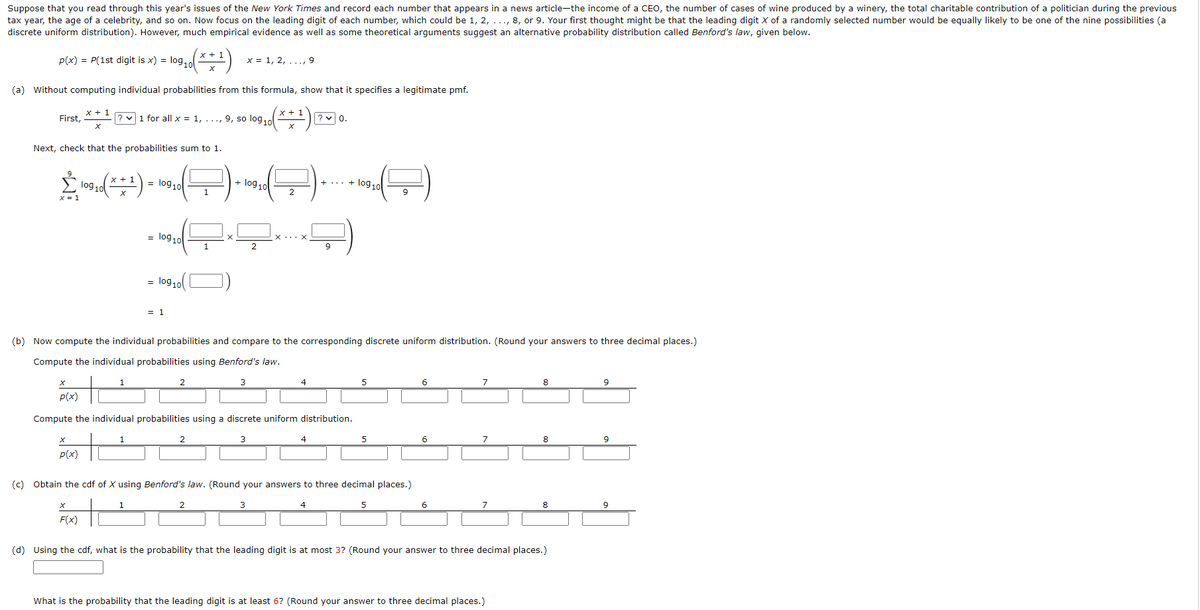Suppose that you read through this year's issues of the New York Times and record each number that appears in a news article-the income of a CEO, the number of cases of wine produced by a winery, the total charitable contribution of a politician during the previou tax year, the age of a celebrity, and so on. Now focus on the leading digit of each number, which could be 1, 2, ..., 8, or 9. Your first thought might be that the leading digit x of a randomly selected number would be equally likely to be one of the nine possibilities (a discrete uniform distribution). However, much empirical evidence as well as some theoretical arguments suggest an alternative probability distribution called Benford's law, given below. P(x) = P(1st digit is x) = log,l x = 1, 2, ..., 9 (a) without computing individual probabilities from this formula, show that it specifies a legitimate pmf. „ 9, so log,o**1)2 0. First, x+1 21 for all x = 1, Next, check that the probabilities sum to 1. log. = log1o + log +..+ log10 = log1o = log1ol = 1 (b) Now compute the individual probabilities and compare to the corresponding discrete uniform distribution. (Round your answers to three decimal places.) Compute the individual probabilities using Benford's law. 3 4 P(x) Compute the individual probabilities using a discrete uniform distribution. 6 P(x) (c) Obtain the cdf of X using Benford's law. (Round your answers to three decimal places.) (d) Using the cdf, what is the probability that the leading digit is at most 3? (Round your answer three decimal places.) What is the probability that the leading digit is at least 6? (Round your answer to three decimal places.)
Suppose that you read through this year's issues of the New York Times and record each number that appears in a news article-the income of a CEO, the number of cases of wine produced by a winery, the total charitable contribution of a politician during the previou tax year, the age of a celebrity, and so on. Now focus on the leading digit of each number, which could be 1, 2, ..., 8, or 9. Your first thought might be that the leading digit x of a randomly selected number would be equally likely to be one of the nine possibilities (a discrete uniform distribution). However, much empirical evidence as well as some theoretical arguments suggest an alternative probability distribution called Benford's law, given below. P(x) = P(1st digit is x) = log,l x = 1, 2, ..., 9 (a) without computing individual probabilities from this formula, show that it specifies a legitimate pmf. „ 9, so log,o**1)2 0. First, x+1 21 for all x = 1, Next, check that the probabilities sum to 1. log. = log1o + log +..+ log10 = log1o = log1ol = 1 (b) Now compute the individual probabilities and compare to the corresponding discrete uniform distribution. (Round your answers to three decimal places.) Compute the individual probabilities using Benford's law. 3 4 P(x) Compute the individual probabilities using a discrete uniform distribution. 6 P(x) (c) Obtain the cdf of X using Benford's law. (Round your answers to three decimal places.) (d) Using the cdf, what is the probability that the leading digit is at most 3? (Round your answer three decimal places.) What is the probability that the leading digit is at least 6? (Round your answer to three decimal places.)
Chapter9: Sequences, Probability And Counting Theory
Section9.5: Counting Principles
Problem 42SE: In horse racing, a “trifecta” occurs when a bettor wins by selecting the first three finishers in...
Related questions
Question

Transcribed Image Text:Suppose that you read through this year's issues of the New York Times and record each number that appears in a news article-the income of a CEO, the number of cases of wine produced by a winery, the total charitable contribution of a politician during the previous
tax year, the age of a celebrity, and so on. Now focus on the leading digit of each number, which could be 1, 2, ..., 8, or 9. Your first thought might be that the leading digit X of a randomly selected number would be equally likely to be one of the nine possibilities (a
discrete uniform distribution). However, much empirical evidence as well as some theoretical arguments suggest an alternative probability distribution called Benford's law, given below.
x + 1
x = 1, 2, ..., 9
P(x) = P(1st digit is x) = log,o
(a) without computing individual probabilities from this formula, show that it specifies a legitimate pmf.
x+ :
? v1 for all x = 1, ..., 9, so log,o
? v 0.
x + 1
First,
Next, check that the probabilities sum to 1.
lo910
+ log 10
log10
log 10
9
1
log 10
1
9
lo9 10
= 1
(b) Now compute the individual probabilities and compare to the corresponding discrete uniform distribution. (Round your answers to three decimal places.)
Compute the individual probabilities using Benford's law.
6.
7
8
9
2.
3
4
5
P(x)
Compute the individual probabilities using a discrete uniform distribution.
6
8
3
4
1
P(x)
(c) Obtain the cdf of X using Benford's law. (Round your answers to three decimal places.)
6
7
9
3
4
F(x)
(d) Using the cdf, what is the probability that the leading digit is at most 3? (Round your answer to three decimal places.)
What is the probability that the leading digit is at least 6? (Round your answer to three decimal places.)
Expert Solution
This question has been solved!
Explore an expertly crafted, step-by-step solution for a thorough understanding of key concepts.
This is a popular solution!
Trending now
This is a popular solution!
Step by step
Solved in 6 steps

Recommended textbooks for you


Algebra & Trigonometry with Analytic Geometry
Algebra
ISBN:
9781133382119
Author:
Swokowski
Publisher:
Cengage



Algebra & Trigonometry with Analytic Geometry
Algebra
ISBN:
9781133382119
Author:
Swokowski
Publisher:
Cengage
